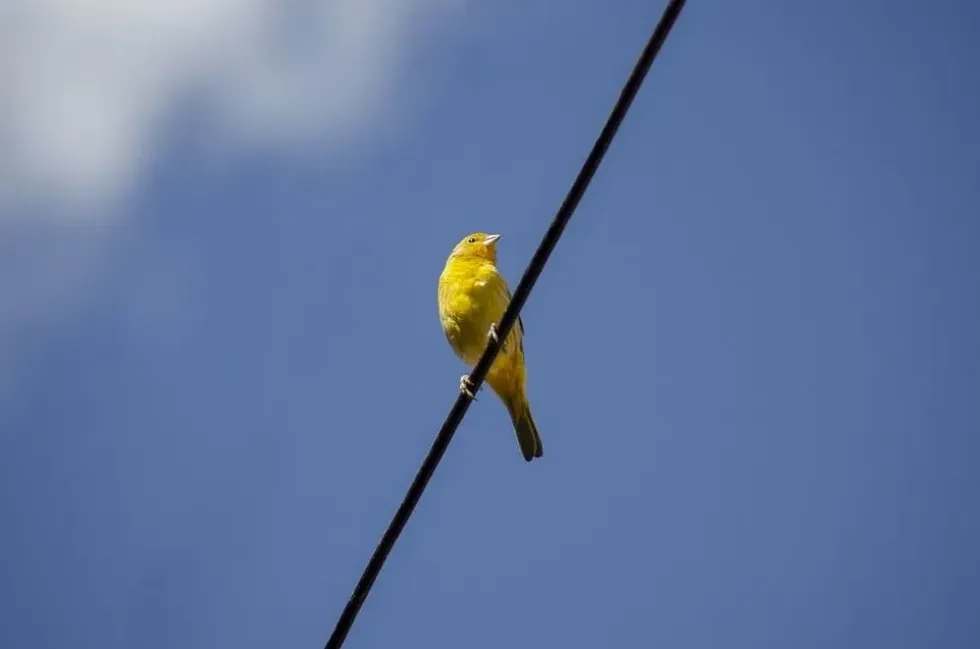The saffron finch (Sicalis flaveola), is a tanager bird native to South America. It is about 5.25-5.5 in (13.5-14 cm) long and weighs about 0.7-0.8 oz (20-22 g).
A male and female saffron finch have only slightly different features. A male is bright yellow, while a female's body is duller, it is olive-brown with heavy dark streaks. Saffron finches belong to the order Passeriformes, family Thraupidae, and genus Sicalis of birds.
Although the saffron finch lives with other finches in flocks during the winter, it shows a unique breeding behavior. It is polygamous and is very protective of its territory when nesting.
It picks on smaller birds, its mate, and juveniles during the breeding season and shows quite aggressive behavior. For this reason, in Brazil, the saffron finch is bred and sold into illegal bird fighting rings.
Despite this, the saffron finch is one of the easiest birds to care for in a domestic setting, as it has an easy diet, and needs low levels of maintenance. Also, its sweet, mild, and repetitive songs make for a nice melody to hear around the home.
Find out more about the bright yellow saffron finch here, or learn about other birds like the house finch and the red finch.
Saffron Finch Interesting Facts
What type of animal is a saffron finch?
The saffron finch is a tanager bird from the order Passeriformes, family Thraupidae, and genus Sicalis.
What class of animal does a saffron finch belong to?
The saffron finch belongs to the Aves class of birds.
How many saffron finches are there in the world?
The exact population of saffron finches isn't known. However, since it is classified as a species of Least Concern by the IUCN, we know that there are more than 10,000 mature individuals in the world.
Where does a saffron finch live?
The saffron finch lives mainly in the grasslands and river valleys of South America.
What is a saffron finch's habitat?
A saffron finch's habitat usually is a lowland in its native country of South America, which is open or semi-open, and near the Amazon Basin. It is found near brushy areas, grasslands, and river valleys.
It is also known to inhabit semi-arid places and places with human populations such as gardens and parks. They live in nests during the breeding season, in the hollows of trees, rocks, walls, or in abandoned hornero's nests. They do not migrate.
Who do saffron finches live with?
In the winter, saffron finches live in flocks and they live with their breeding mates in the spring.
How long does a saffron finch live?
A saffron finch usually lives for 10-12 years.
How do they reproduce?
Saffron finches reproduce by mating with the opposite sex. After mating, the hen lays three to seven eggs, which she incubates for 12-14 days. After hatching, a chick is fed by both parents.
What is their conservation status?
The conservation status of saffron finches is currently Least Concern.
Saffron Finch Fun Facts
What do saffron finches look like?
Males and the females of the saffron finch (Sicalis flaveola) species of birds look alike, except for the fact that females' bodies are duller. A saffron finch has a bright yellow body.
Its upper beak is black-gray and its lower beak is ivory and pale. Its underparts are yellow, and its back is a greenish-yellow color.
Its legs look pink and gray, and its wings and tail feathers are black with yellow linings. The male has an orange crown on the forehead, and the female has darker streaks on her crown. The eyes of a saffron finch are dark.
The presence of the dominating orange and yellow colors on this bird makes it look saffron, hence the name 'saffron' finch. Juveniles have darker streaks and their bodies are mostly gray.
How cute are they?
Saffron finches are very cute birds. Their petite sizes and brightly colored bodies are very pleasing to the eye, and their sweet, repetitive, and sweet-sounding songs make them even more endearing.
How do they communicate?
Saffron finches communicate via songs that are repetitive and sweet.
How big is a saffron finch?
The saffron finch is a small bird that is about 5.25-5.5 in (13.5-14 cm) long, which makes it about 15-20 times smaller than a North African ostrich!
How fast can a saffron finch fly?
A saffron finch can fly at speeds of about 13-32 mph (20.9-51.5 kph).
How much does a saffron finch weigh?
A saffron finch weighs about 0.7-0.8 oz (20-22 g).
What are the male and female names of the species?
Males of the saffron finch species are called 'cocks', and females are called 'hens'.
What would you call a baby saffron finch?
A baby saffron finch is called a 'chick'.
What do they eat?
Saffron finches are omnivores, and they eat millets, wild seeds, canary grass seeds, oat groats, and lots of green food.
Are they dangerous?
Saffron finches are not aggressive toward humans, but they do exhibit aggressive behavior. Saffron finches are polygamous birds, meaning that during their breeding season, they may have more than one mating partner.
They do not mate for life. During this time they can be very territorial creatures and they are protective of their nests. Due to this, they are bullish towards smaller birds and are even known to be violent towards females and juveniles during their spring breeding season.
Would they make a good pet?
Yes, thanks to their sweet songs and bright appearance they make a good pet, but remember that good care has to be taken of saffron finches. A saffron finch kept in an aviary cage favors insects in its diet more than any other food.
Their diet should also have plenty of greens.
The cage should be kept at a height and in a corner. Also, the cage should not be small, and if your bird is to have a companion, it should be of the same size and not smaller.
Did you know...
The list of South American countries in the habitat range of a saffron finch includes the Netherlands Antilles, the Guyanas, Ecuador, Paraguay, Uruguay, Venezuela, Brazil, Trinidad, and Tobago, Peru, Argentina, Suriname, and Colombia. The saffron finch has also been introduced to Hawaii, Jamaica, and Puerto Rico.
With all of these combined, the saffron finch can be found in a wide distribution of countries. A subspecies named S. f. flaveola has also been identified in Trinidad and Tobago.
The saffron finch favors the open and semi-open lowlands near the Amazon Basin of South America.
Their bright yellow body and orange crown separate the saffron finch from the yellow finch.
The easiest distinguishing factor between males and females is the presence of an orange crown. Only males have this orange crown, while females, being a duller version of the male bird, have dark streaks on their heads instead of an orange crown.
The saffron finch has been introduced to North America only through the pet industry, and if one is sighted in the wild in places in North America, it is likely to be a vagrant bird that has escaped its cage or aviary.
The saffron finch is one of the few species of birds to have a lower beak and an upper beak of different colors.
The saffron finch is a species that shows peculiar pre-breeding behavior. The male and the female both collect materials for their nest and, after making the nest, the cock provides the hen with food.
Then, the cock follows the hen with the feathers on his neck standing up, and his wings slouched. He dances, sings, bows, and vibrates his wings to try to convince the hen to mate.
During the time the hen spends incubating the eggs, it is the cock's responsibility to guard the nest.
Where do finches make their nests?
A saffron finch (Sicalis flaveola) does not make its own nest from scratch in the wild. Instead, it makes use of crevices and hollows in rocks and walls and is even known to use abandoned mud nests built by the Rufous hornero.
To build a nest, both the male and the female gather materials, and the male gathers food. They use things like fibers, leaves, grasses, soft feathers, and roots.
Are finches good for beginners?
Finches make great birds for beginners to have as pets. Their beautiful appearance and sweet songs make it a fun presence to have in an aviary.
Since their bodies are small and feeding them is easy, these birds make great pets for families with children as well. Care should be taken to introduce them to potential mating partners in the winter, to build familiarity in the run-up to spring, which is the mating season when males are known to get aggressive.
Here at Kidadl, we have carefully created lots of interesting family-friendly animal facts for everyone to discover! Learn more about some other birds including the bee hummingbird or the Indian peafowl.
You can even occupy yourself at home by drawing one on our Saffron finch coloring pages.









